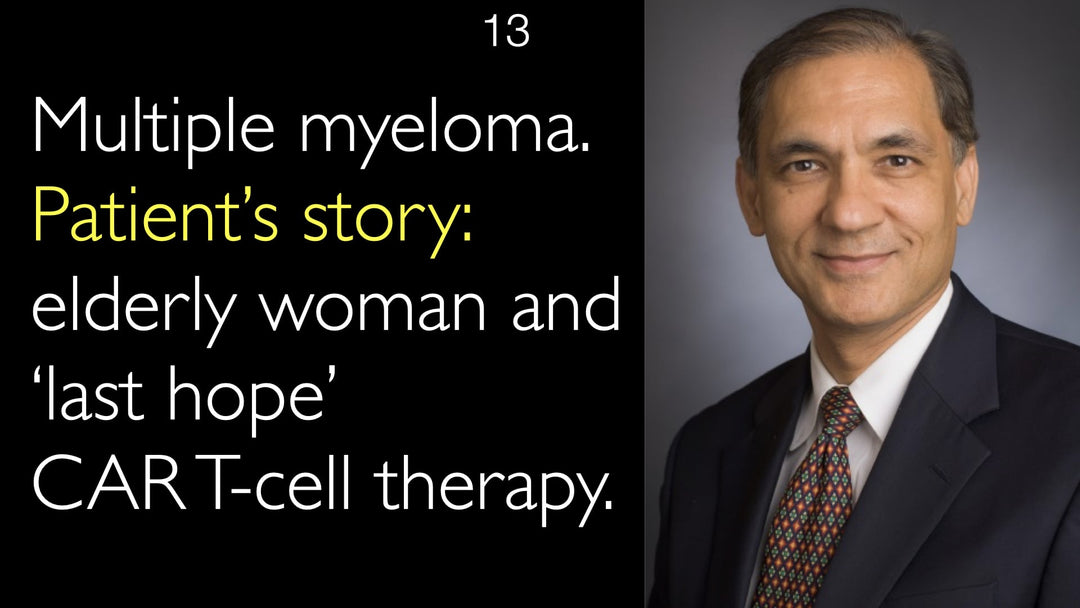Den ledande hematologiexperten, Dr. Aric Parnes, förklarar hur man identifierar orsaken till anemi. Han går igenom två viktiga blodprover: retikulocyträkningen och medelkorpuskulär volym (MCV). Dessa prover hjälper till att avgöra om anemin beror på blödning, nedbrytning av röda blodkroppar eller bristande produktion. Dr. Parnes diskuterar vanliga orsaker som järnbrist och tjocktarmscancer. Han tar också upp behandlingsalternativ, inklusive intravenöst järn och erytropoetin-injektioner vid kronisk njursjukdom.
Diagnostik av anemi: Viktiga blodprover för att identifiera den bakomliggande orsaken
Hoppa till avsnitt
- Två nyckelblodprover för anemidiagnostik
- Förhöjd retikulocyträkning: Blödning och hemolys
- MCV-analys: Storleken på röda blodkroppar och dess betydelse
- Identifiera dolda blödningskällor
- Modern behandling av olika anemityper
- Fullständig transkription
Två nyckelblodprover för anemidiagnostik
Dr. Aric Parnes, specialist inom hematologi, lyfter fram två avgörande blodprover för att identifiera orsaken till anemi. Det första är retikulocyträkningen, som mäter unga röda blodkroppar. En förhöjd räkning tyder på att benmärgen kompenserar för blodförlust eller nedbrytning av blodkroppar.
Det andra viktiga provet är medelkorpuskulär volym (MCV), som mäter den genomsnittliga storleken på röda blodkroppar. MCV-värdet hjälper till att kategorisera anemin och kan peka på specifika nutritionsbrister eller underliggande benmärgssjukdomar.
Förhöjd retikulocyträkning: Blödning och hemolys
En hög retikulocyträkning indikerar att kroppen försöker ersätta förlorade röda blodkroppar. Enligt Dr. Aric Parnes beror detta ofta på blödning, som kan vara synlig (t.ex. från ett sår) eller dold inuti kroppen.
En hög räkning kan också tyda på hemolys, det vill säga nedbrytning av röda blodkroppar inuti kroppen. Dr. Parnes påpekar att autoimmun hemolytisk anemi är en vanlig orsak, där immunsystemet av misstag angriper de egna röda blodkropparna.
För att bekräfta hemolys krävs ytterligare laboratorieprover. Dr. Parnes nämner tre nyckelmarkörer: förhöjda nivåer av laktatdehydrogenas (LDH) och bilirubin, samt nedsatt haptoglobin. Dessa bekräftar att nedbrytning av röda blodkroppar pågår.
MCV-analys: Storleken på röda blodkroppar och dess betydelse
Medelkorpuskulär volym (MCV) är ett kraftfullt diagnostiskt verktyg. Dr. Aric Parnes förklarar hur MCV-värden styr diagnostiken. En låg MCV indikerar mikrocytär anemi, med för små röda blodkroppar, ofta orsakad av järnbrist eller talassemi.
En hög MCV tyder på makrocytär anemi, med större än normala celler, vilket ofta beror på brist på vitamin B12 eller folat. Dr. Parnes noterar också att benmärgssjukdomar som myelodysplastiskt syndrom eller aplastisk anemi kan ge hög MCV.
En normal MCV pekar ofta på anemi vid inflammation, tidigare kallad anemi vid kronisk sjukdom. Dr. Anton Titov och Dr. Parnes diskuterar hur kronisk njursjukdom är en vanlig orsak till denna typ av anemi.
Identifiera dolda blödningskällor
Occult blödning är en vanlig och allvarlig orsak till anemi. Dr. Aric Parnes betonar att mikroskopisk blodförlust kan vara det första tecknet på ett allvarligare hälsoproblem, som kolonpolyper eller tjocktarmscancer i mag-tarmkanalen.
Diagnostisering kräver specifika procedurer. Koloskopi är avgörande för att undersöka tjocktarmen och identifiera polyper eller tumörer. Om koloskopin är negativ, utförs en övre endoskopi för att undersöka magsäcken och duodenum efter sår, gastrit eller sällsynta tumörer som gastrointestinala stromala tumörer (GIST).
Dr. Parnes understryker vikten av dessa undersökningar för att hitta och behandla blödningskällan, vilket är avgörande för att lösa anemin och adressera den underliggande sjukdomen.
Modern behandling av olika anemityper
Behandlingen av anemi beror helt på dess orsak. Dr. Aric Parnes beskriver moderna terapeutiska alternativ. För järnbrist är orala järntillskott första valet, men många patienter drabbas av biverkningar som magbesvär.
Intravenöst järn erbjuder ett effektivt alternativ. Dr. Parnes förklarar att IV-järn kan återställa järnnivåer på minuter, jämfört med månader för orala tabletter. För anemi vid kronisk njursjukdom används erytropoetinsubstitutionsterapi.
Erytropoetin (EPO) är ett hormon som produceras av friska njurar. Injektioner av syntetisk EPO (som Epoetin eller Darbepoetin) stimulerar benmärgen att producera röda blodkroppar. Denna behandling, som ges veckovis eller månadsvis, hanterar anemi effektivt och minskar behovet av blodtransfusioner. Dr. Anton Titov noterar att EPO också används vid anemi orsakad av myelodysplastiskt syndrom.
Fullständig transkription
Dr. Anton Titov, MD: Hur hittar man orsaken till anemi? Två nyckelblodprover visar orsaken till anemi. Varför har du anemi? Ett fullständigt blodstatus kan hjälpa till med diagnostik. Hur kan anemi vara ett första tecken på tjocktarmscancer? Hur hittar man den verkliga orsaken till anemi? Hur behandlar man anemi vid kronisk sjukdom?
En expert inom hematologi diskuterar två viktiga blodprover för att hitta den exakta orsaken till anemi. Hur man hittar orsaken till anemi. Två nyckelblodprover.
Dr. Anton Titov, MD: Hur diagnosticeras anemi? En videointervju med en expert inom hematologi om diagnostik av anemi. En medicinsk second opinion vid anemi hjälper till att säkerställa att orsaken hittas.
Dr. Aric Parnes, MD: En medicinsk second opinion säkerställer att diagnosen är korrekt och fullständig. Två blodprover är avgörande för att identifiera orsaken till anemi hos män och kvinnor. Retikulocyträkning mäter unga erytrocyter och fastställer om blödning eller nedbrytning av röda blodkroppar sker.
De vanligaste orsakerna till anemi är järnbrist och kronisk blödning. Hos kvinnor kan kraftiga mensblödningar vara en orsak.
Dr. Anton Titov, MD: Anemi kan vara ett tecken på tjocktarmscancer eller polyper. En cancerös polyp kan blöda in i tarmen utan att märkas, varför koloskopi och tester för occult blod i avföringen är viktiga.
Hur hittar man orsaken till anemi vid kronisk sjukdom? En medicinsk second opinion hjälper också till att välja rätt behandling. Vad orsakar anemi hos barn? Järnbrist är en vanlig orsak.
Dr. Aric Parnes, MD: Hur självdiagnostiserar man anemi? Du kan göra ett fullständigt blodstatusprov och titta på retikulocyträkning och MCV, men besök en hematolog för en exakt diagnos och behandling.
Anemidiagnostik kräver erfarenhet. En expert kan också ge en second opinion. Hur hittar man orsaken med begränsade resurser? Starta med MCV och retikulocyträkningar.
Behandling av anemi vid kronisk sjukdom med erytropoetininjektioner. En videointervju med en expert inom hematologi och onkologi. En second opinion bekräftar diagnosen vid t.ex. aplastisk anemi.
Dr. Anton Titov, MD: En second opinion bekräftar också om behandling behövs och hjälper till att välja den bästa terapin. Var säker på att din behandling är optimal.
Anemiorsaker och differentialdiagnos. Hur man hittar orsaken till anemi.
Dr. Anton Titov, MD: Anemi är ett centralt ämne inom hematologi och kan vara ett tecken på många sjukdomar. Ibland har en person för lågt antal röda blodkroppar.
Vilka steg följer en hematolog för att identifiera orsaken? Kan du ge exempel på vanliga orsaker?
Dr. Aric Parnes, MD: Visst. Två laboratorietest är särskilt viktiga. För det första: retikulocyträkningen. Retikulocyter är unga röda blodkroppar.
Om en person blöder eller om erytrocyter förstörs (hemolys), kommer benmärgen att svara med att producera fler blodkroppar, och retikulocyträkningen ökar. Om den inte ökar, kan det vara ett produktionsproblem i benmärgen.
Det andra testet är MCV, medelkorpuskulär volym, som visar storleken på röda blodkroppar. Personer med järnbrist eller talassemi har små celler (låg MCV). Personer med B12- eller folatbrist, eller vissa benmärgssjukdomar, har stora celler (hög MCV).
Patienter med normal MCV har ofta anemi vid inflammation, till exempel vid kronisk njursjukdom, där njurarna inte producerar tillräckligt med erytropoetin.
Retikulocyträkning och MCV ger oss en bred förståelse av orsaken.
Ett exempel: om retikulocyträkningen är förhöjd, tänker jag genast på blödning eller hemolys. Blödning kan vara svår att upptäcka, så koloskopi kan behövas.
Dr. Anton Titov, MD: Diagnostisering av dold blödning är viktigt. Tjocktarmspolyper eller cancer kan orsaka mikroskopisk blödning, vilket kan vara ett tidigt tecken på cancer. Occult blodtest och koloskopi är nyckelverktyg.
Dr. Aric Parnes, MD: Precis. Koloskopi screener för cancer och polyper. Om negativ, görs övre endoskopi för att söka efter magsår, gastrit eller andra källor.
Dr. Anton Titov, MD: Källor till övre GI-blödning kan inkludera sällsynta tumörer som GIST.
Dr. Aric Parnes, MD: Ja. Ibland finns ingen blödning, utan frågan är om hemolys förklarar det höga retikulocytantalet.
En vanlig orsak är autoimmun hemolytisk anemi, där immunsystemet angriper blodkropparna. För att bekräfta letar vi efter förhöjda LDH och bilirubin, och nedsatt haptoglobin.
Dr. Anton Titov, MD: Det är viktigt att skilja mellan blödning och hemolys.
Dr. Aric Parnes, MD: Ibland har patienter nutritionsbrist, som är lätt att korrigera. Järnbrist kan vara svårare att behandla på grund av biverkningar från tabletter. IV-järn är ett effektivt alternativ som verkar snabbt.
För anemi vid kronisk njursjukdom används erytropoetininjektioner (t.ex. Epoetin, Darbepoetin), vilka ges veckovis eller månadsvis och minskar behovet av transfusioner.
Dr. Anton Titov, MD: Erytropoetin används också vid myelodysplastiskt syndrom.
Hur hittar man orsaken till anemi? En videointervju med en expert. Två nyckeltest: retikulocyträkning och MCV.
Hur hittar man orsaken till anemi? Två blodprover visar sannolika orsaker. Hur kan anemi vara ett första tecken på cancer? Hur hittar man den verkliga orsaken? Hur behandlar man anemi vid kronisk sjukdom?
En expert inom hematologi diskuterar två viktiga blodprover för att hitta den exakta orsaken.








